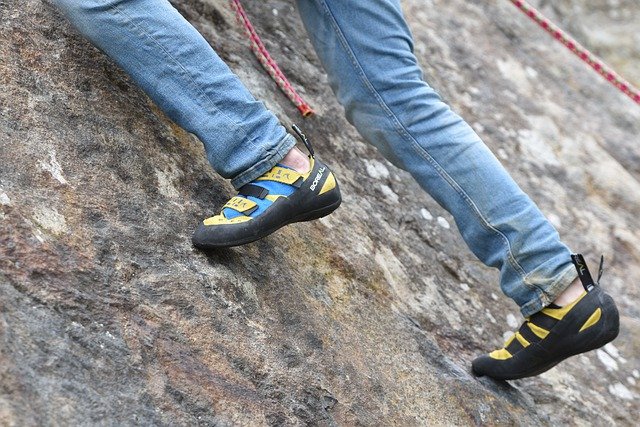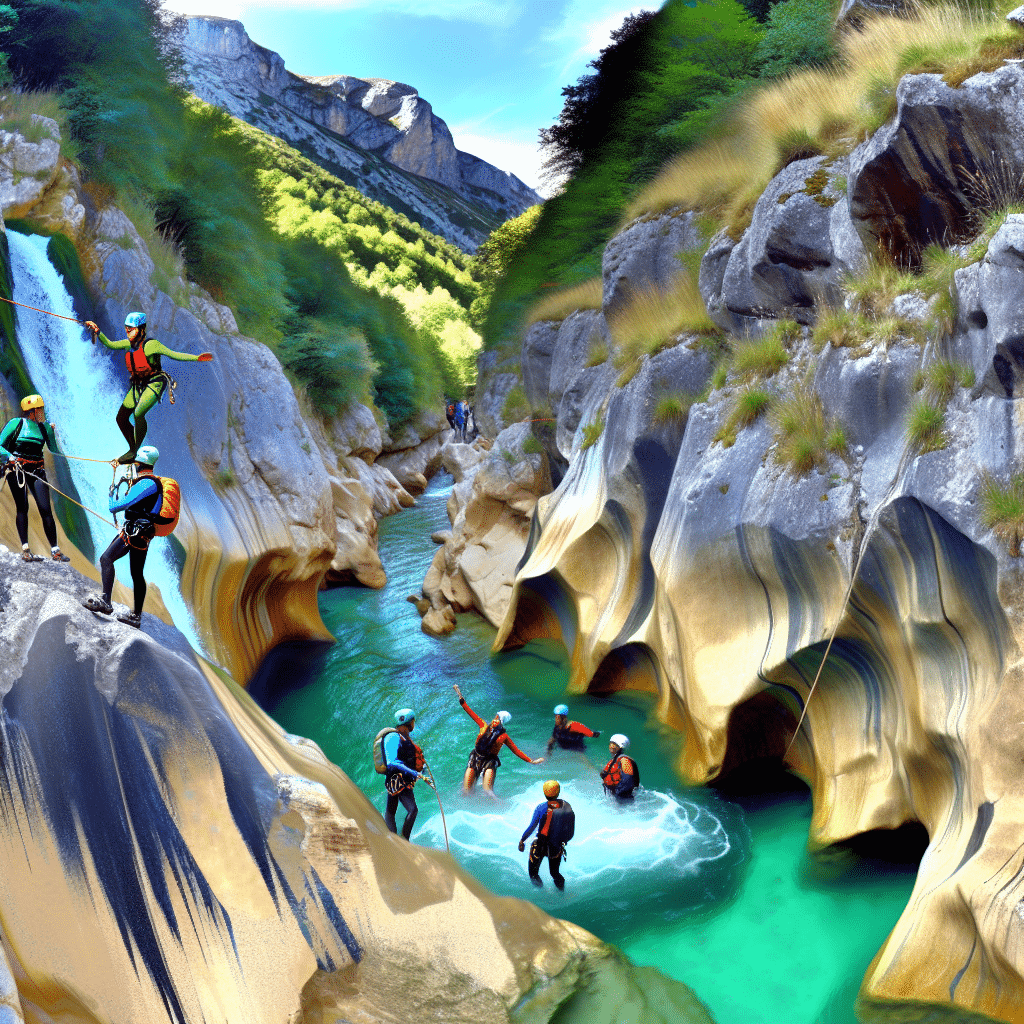Rock climbing shoes are the interface between you and the rock, and the wrong type of shoe or fit can hold you back. When choosing climbing shoes, there are several considerations.

Table of Contents
Your foot size
How wide your feet are. The shape of your toes (straight across or tapered). Your climbing ability level (how advanced you are). The style of indoor or outdoor climbing you prefer to do most often. The type of rock you climb on most often (plenty of cracks? lots of small footholds? big holds?).
Your shoe size
Feet come in lots of shapes and sizes, and climbing requires a certain degree of precision. But there is no perfect “universal” fit that works well for everyone. You can find excellent shoes that will work for your feet though, as long as you inform yourself about what fits into which category, and then try on as many different models as possible. An analogy would be buying a pair of jeans – every brand fits differently depending upon the cut and materials used. For snug climbing shoes we recommend erring on the side of too small, because we can always wear them tighter but we can’t un-stretch them.
The shape of your toes
Some climbers have tapered toes (pointier) while others have more rounded tips. Climbing shoes are also made to accommodate both types of toe shapes, which is why you should test out as many different models as possible to see what fits best for you .
Climbing ability level
People who are newer to climbing tend to favor a more versatile shoe with an asymmetrical shape and thicker rubber soles. But experienced climbers often prefer a slimmer profile shoe with thinner rubber that helps them feel the rock better, especially on steeper terrain or when climbing tiny nubbins. The type of indoor climbing
Climbing shoe features and rubber types vary dramatically between indoor and outdoor shoes. While both kinds of climbing shoes will stretch quite a bit, some styles will become floppy on the rock and others stay closer to their original shape even after hours of use. Rubber type may be important for your ability level as well – if you mostly climb indoors then stick with velcro (stickier) or even double-sided velcro (the stickiest). If you climb more outdoors, laces work better for fine tuning the fit.
The type of rock
Different types of rock will emphasize different attributes in your climbing shoe . Some shoes are made specifically for smearing and grabbing tiny holds while others excel at edging on small pockets, and still other models are designed for durability and comfort.
Your fitting goals
Do you want to be able to wear them for hours on end? Are you hoping to take the shoes out of the box and never have to adjust them again?.
Knowing what type of climbing shoe fits your foot will help narrow down your choices, but it is always better to try a few different types of shoes on before – just as is important with jeans – so keep that in mind when going shopping, and don’t buy online unless you can thoroughly check out a model via video or another means.
The ultimate time to fit a shoe properly is at the very beginning – if possible, borrow from someone who has already been using their climbing shoes long enough for them to break in and stretch, and try on both right and left shoes so you can compare them side-by-side. It never hurts to go a size down from what your foot measures – we all know better than the charts anyway – because your toes will be bent up against the shoe’s wall inside of it. Remember though, that this is not necessary with all styles, only some are designed with an asymmetrical shape for comfort.
What is special about rock climbing shoes?
Properly fitted rock climbing shoes are also your most important piece of protection while going vertical. If you have a shoe that doesn’t fit you properly, it can turn a simple climb into a nightmare by causing blisters and hotspots that will make climbing impossible.
When trying the shoes on take note how the upper part flexes at your toes when standing in them or taking a few steps. Tighten the laces to get an idea of how they would feel when edging on small holds or toeing in pockets, and take care not to over-tighten the flat nylon strap at the top of some models because it can prevent you from putting them on or taking them off. Just like with jeans, buying an ill-fitting climbing shoe can be the difference between a great climbing experience and one that leaves you feeling miserable.
Can you rock climb with normal shoes?
Yes and no: there is a difference between climbing shoes and trainers even though you might be able to wear some models of each kind. Climbing feet are harder than walking feet, which means that your trainer will not last as long as climbing shoe (not to mention the fact that it may be ill-fitting). Specific features like rubber thickness or shape make them totally different from normal walking shoes.
Are rock climbing shoes the same size as regular shoes?
Similar, but not the same. Climbing shoes are designed to fit snugly and may be a little narrower than you expect. There’s no need to size up and buy extra room because climbing shoes stretch with time and use.
Can you buy climbing shoes online?
It is not recommended. Even if you are able to find the exact shoes on the internet, there are no guarantees that they will fit properly or be right for your ability level. And if the online retailer doesn’t have a good return policy it can be tricky to get your money back on poor-fitting rock climbing shoes .
What shoes does Alex Honnold wear?
Alex Honnold, the famous free solo climber has recently done several speed records on big walls (El Capitan) wearing Evolv shoes. He is sponsored by The North Face and Mammut .
Why are climbing shoes expensive?
They are not just sneakers: rock climbing shoes need to be specialized pieces of equipment that provide support and traction. They come in a variety of shapes and sizes, which means they can’t be made from the same materials or even by the same manufacturers as regular shoes (like Converse). Making them not only costs more but requires highly skilled workers and special techniques.
What does toe rubber thickness mean?
The rubber on your toes is called the “toe rand” because it helps protect against wear and tear when you’re edging or toeing into small surface irregularities. A thicker toe rubber means that your shoes will last longer before you get through all five pairs that you initially started with, but some climbers prefer soles with less thickness because it allows them to feel the rock better.
How tight should climbing shoes be?
The wrong size can be a big problem: too loose and they will slip off when you’re hanging on to flakes or thin edges, while too tight can lead to discomfort and painful blisters. To get a proper fit, wear thin socks that will allow your toes to spread out without being restricted in their movements. It’s also a good idea to buy new shoes a half-size larger than your street shoe size if you want a little extra room for comfort .
What do “lasted”, “lined”, and “seamless” mean?
In order from least durable to most durable: lasted shoes have an attached tongue and lining, which means that the sole is glued to the shoe and cannot be replaced; lined shoes also have a tongue but it is not attached and can sometimes be removed and replaced (although the lining usually cannot); and finally, there are seamless shoes that do not have tongues at all. Lined or “soft-sole” models will stretch out easier than solid ones, but they won’t last as long since you can wear them down more easily.
What should climbing shoes feel like?
They should fit snugly without feeling too tight: as soon as you take them off your toes should curl up slightly because they’ve been resting in one locked position for the duration of your climb. Climbing shoes that don’t fit like this (like when your toes curl up in regular gym socks) will cause pain and lead to early fatigue.
What is the difference between Velcro climbing shoe closures and laces?
Velcro shoes are generally easier to take on and off, but they can slip if you’re not careful when tightening them. Laced shoes (like rock boots ) provide a superior fit because they can be adjusted with small motions rather than all at once. However, it may take a little longer to put them on or take them off using the laces, which means that transitioning from climb to climb might be slower.
How do I care for my rock climbing shoes?
Climbing shoes should be rinsed after session: dust and dirt can clog up the rubber and worn out laces can snap. You should also consider using a brush to knock off any particles that are stuck in the sole. Then, store your rock climbing shoes in a place with low humidity (like your closet), ideally with their tongues removed to avoid stretching them out over time.
How often do you need replacement?
There is no set rule for how long your climbing shoes will last: some climbers wear through five pairs throughout an entire year while others might get two or more years from just one pair. It’s all about how much you climb, what type of terrain you favor, and how heavy-handed you are when securing footholds.



